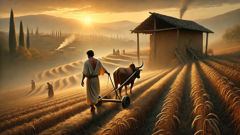Introduction
When the villagers of the hollowed valley spoke of the old woods, they used two words with the same breath: fear and respect. The forest there was no mere backdrop; it was a living book of memory, a place where the wind read stories aloud through the leaves and the roots hid the footprints of a hundred generations. They called her Muma Pădurii — the Mother of the Forest — and they imagined her as both guardian and tormentor: a woman with eyes like dark hollows and hair like the lichen that clings to beech bark, a shape that could be kind as a grandmother one moment and a thing of ragged teeth the next. Folk spoke of offerings left at the edge of the trees — a bowl of milk, a ribbon tied to an elder bough, a coin buried beneath an acorn — gestures meant to keep the forest's appetite sated and its moods gentle. But the tales were never simple comforts; they were warnings couched as story. Mothers sang songs that doubled as maps: verses that told children to never stray past the stone cross, to count their steps on certain nights, to leave the light of home burning until dawn. The oldest tales, the ones that killed laughter in the hearth, said Muma Pădurii walked the shadowed tracks between ancient oaks and took those who wandered alone. Sometimes she did not need to take; sometimes she lured. She could sound like the crying of a babe or the whisper of the beloved one left at home. She promised warmth and bread, then led the trusting into bog and bramble where roots formed nooses and the moss swallowed voices. Yet even as she frightened them, the villagers named things after her as if naming softened the danger: Muma's Oak, Muma's Spring. They carved signs, taught charms, measured the distance from their threshold to the first furrow of moss. The forest was a presence that required ritual and offer and a sort of wary conversation. From these early murmurs the larger story grew — of lost children, of moonlit rescues, of bargains struck in the hollows beneath the stones. It is the sort of story that sits between a warning and a remembrance, a tale that stitches the community to the wild around it and keeps alive the fragile law that human life depends as much on cleverness as on courage.
Roots of Fear: Origins and Omens of the Muma
The Muma Pădurii belongs to a kind of fear older than parish records. Her story grows from a landscape that curves and hides: deep hollows where fog gathers, ravines that drink the sound of a footstep, and ridges where weather turns sudden and merciless. In the earliest versions villagers said she was born of grief — a woman whose child had been taken by winter and cold and who returned to the land, not as a gentle ancestor but as a force that demanded payment in flesh. In other tellings she was older still, a guardian twisted by insult, a spirit of the trees who punished those who cut without thanks, grazed without care, or treated the streams like drains. Whatever origin one favoured, the effect was universal: Muma Pădurii became shorthand for the law the forest exacted. She was not merely malice; she was a test of boundaries. If you respect the forest, she glances away. If you scar it, she notices. Her presence made the villagers invent customs to bind the wild. They tied threads of red to saplings so the Mother would see their respect. They buried bread in the earth and poured milk on roots. They left carved figures at the edge of spring-fed wells: simple wooden mothers who embodied gratitude and also stood as placards of human claim. The rituals were practical as well as spiritual. A traveller with a notch in his staff might be recognized by neighbouring villages; a child who learned the counting-song would avoid wandering. Muma’s methods were as protean as the forest itself. She could come as a lullaby sung behind a fence, calm and coaxing, or as the rustle of a dress through bracken. People who were taken rarely returned unchanged. There are tales of children found years later at the root of an old oak, hair long and eyes black with an otherworldly patience, speaking in a measured voice of time passed differently beneath the canopy. In such stories, the forest had its own seasons of time: summers that lasted days and days that stretched like winter. The problem with these tales was their usefulness; they taught villages how to stay alive by telling them when to fear and when to offer. Even in the courtroom records of later centuries the phrase Muma Pădurii accompanied certain disappearances, and elders would murmur the name when a storm stripped apples from trees or when livestock returned thin. Folklore helped people explain loss. In exchange, the fear shaped their lives. The architecture of the hamlet responded to it: fences were higher on the side facing the woods; doors were bolted with iron hammered once on the full moon; little carved crosses were nailed under lintels as a third eye against enchantment.

But alongside the practical rites grew a repertory of stories designed to teach cunning. These were longer, more narrative tales about the ways a person might trick the Muma as much as they might please her. The tales feature small clevernesses as much as brute force. Some spoke of a string of salt tied to a child's wrist: the witch could not cross salt. Others advised carrying a mirror to show her her own age, for vanity sometimes distracted a spirit long enough for a rescuer to act. There were stories of a ring of bitter wormwood placed in the doorway, of three repeated names spoken aloud to anchor a kidnapped child back to human speech. These devices are not simply gimmicks; they reflect a deeper logic baked into the mythic cosmos where names are anchors and certain substances — salt, iron, bitter herbs — are boundaries between human order and forest chaos. The story-world makes sense when treated as a moral and cosmological map. The Muma will not cross salt because salt marks the hand of community; she fears iron because metal is the craft of human dominion; she recoils from certain songs because music contains a binding quality. Consequently, the village’s repertoire became a set of technologies: ways to reclaim what the wild took.
The catalogue of encounters between Muma Pădurii and humans is long and varied. Some tales emphasize mercy: a child, honeyed with a lullaby, is left at the edge of a clearing and the old woman returns her, chastened, because the villagers leave an offering by the tree. Other stories end in darkness: a funeral procession trailing candles through a fog, the bones of those who followed a siren call beyond a stone. Then there are the stories of those who resisted — the heroes whose courage bolstered the community's faith. Heroes in these tales are rarely pure knights; they are woodcutters, shepherds, a mother with the stubborn vigilance of centuries. Their victories often hinge on cunning rather than strength: leaving a trail of clothes that leads to a false hearth, singing a child's lullaby to wake the heart that has gone cold, using a newborn's cry as a counter-enchantment. The Muma's vulnerability is paradoxical: she is terrible because she breaks trust, but she is bound to certain patterns because she is, at bottom, woven into the forest's rulebook. Name her, feed her, refuse her — each action draws her into dance. These interactions serve as morality plays, lessons in the limits of human control and in the necessity of living within a social ecology that honors the land. They teach a community how to respond to danger and, in the telling, make the community stronger.
As the centuries advanced into the medieval age and beyond, the figure of Muma Pădurii migrated into parish sermons and the margins of legal codes. Some priests condemned the rituals as superstition, while local magistrates recorded cases where the word 'Muma' surfaced beside accusations of witchcraft and unexplained absences. Yet the stories refused to vanish. They adapted. They were told around village fires, in the hush of winter, to temper the carelessness of children and the overconfidence of brash youth. Storytellers shaped her: sometimes a warning, sometimes a test. In the nineteenth century, collectors of folklore catalogued dozens of variations, each giving the witch a different gait, a different appetite. Scholars would later point out how these variations functioned like a dialect, changing the emphasis depending on what a village most feared at the time — famine, banditry, the encroachment of logging traders. The more the woods were cut and the more the wild retreated, the greater the nostalgia and the sharper the anger in the stories. Muma Pădurii was both a memory of what had been lost and a cautionary mirror reflecting the price of careless progress. Ultimately, the myth endures because it answers our oldest question: how do we live near a power we cannot fully control? The Muma gives an answer composed of taboo, ritual, and communal cunning. It is a code of survival hidden in the shape of a tale.
The Rescue of Little Mara: Cunning, Courage, and the Price of Victory
There is no single definitive story of Muma Pădurii's defeat, because her power is rarely ended so much as evaded or bargained with. Still, one tale became a village legend, told and retold with variations, until its edges were polished by memory. It is the story of Little Mara and the band of desperate townsfolk who dared to go into the wood. Mara was the sort of child who learned to count the steps in a field and hum to the rhythm of a milk pail. One autumn, when the fog came early and the granaries were thin, Mara vanished. She had chased a calf beyond the low wall and into a place the elders called the Devil's Hollow. Her mother, Ana, found only a tuft of her shawl and a ring of flattened grass where a small hand had waved. Panic undercuts the slow, careful thought of ritual. That panic moved through the village like a fever. The magistrate was old and dull; he called for prayers. The priest asked that a procession be sent. But the pragmatic among them — a woodcutter named Ilie, a shepherd named Costin, and a quiet woman who served as wise-woman — knew the rituals and also knew the forest's logic.

They prepared at dusk. Ilie sharpened an iron blade and wrapped it in the ribbon of a red shirt that belonged to Mara's father; the wise-woman boiled wormwood and sweetened bread with salt and laid both beneath a carved figure that represented Muma. Before entering the trees they tied a length of horsehair, threaded with small slivers of iron, from the cottage door to the edge of the wood; the hair was a line to which Mara's name could be tied, a physical anchor. They walked in a small group, a deliberate measure to avoid being scattered by mischief. The wise-woman sang a counting-song, a slow, low thing that sounded more like the creek than a human voice, and it steadied their feet. As they moved deeper, the air changed: leaves closed like shutters and the light thinned to a green that felt thick as wool. They found markers of Muma — mushrooms arranged in a ring, a child's shoe hung on a branch like a bell, a small pile of bones turned pale where black soil showed. Each sign required a response. They laid the salted bread in a hollow and, for a moment, the clearing smelled like ovens and home. It bought them three heartbeats of grace. In the center of the ring a woman waited, not young and not old, but a form that seemed made of the forest itself. Her face — when they glimpsed it — was cracked like old pottery, and for a moment Ilie thought he saw his own daughter's eyes in the hollows of her gaze.
Muma's first device is confusion: voices behind trees, the sound of bootsteps that are not matched by footprints. To resist, the rescuers enacted discipline. They repeated Mara's name until it sounded like a chain. They left a trail of garments, each placed at intervals to fool the forest into thinking a living hearth existed elsewhere. In the stories the mirror often appears as a tool; in this tale it was a child's polished tin plate, found on the path and used as a small mirror. Ilie lifted it and caught the woman's face reflected back, but the angle mattered: when the reflection held her eyes she stumbled, and in that hiccup the wise-woman chanted an old name that belonged to the forest's own lexicon. Names are agreements; saying them aloud calls a thing into accountable presence and, sometimes, binds it. Muma recoiled as if scalded. Her features sharpened and then melted away into the bark. She could change her shape, but she could not unlearn certain limitations written into her old mythic form.
The struggle that followed was less a pitched battle than a trial of wits. Muma used scents to confuse them: the sweet of berries that never existed, the silver smell of a cradle. Ilie burned iron filings to create a scent that made the dog accompanying them whine, a sound that broke a circle of enchantment. Costin played his flute until the notes twisted, and the music turned into a binding song that shook leaves free of their enchantment. The wise-woman had kept a small tuft of a mother's hair in her pocket; when she placed it on the ground and began to braid it with witch-knot rhymes, the air tightened. The child who had been stolen — found huddled beneath the roots of an oak, hair like dried straw, eyes both empty and full — was stubborn like a stone. The name-chaining continued. They washed Mara's face with spring water and fed her salted bread. She blinked and then recognized her mother. Recognition is the most powerful unbinding of all; it calls the stolen piece of personhood back into the human sphere. When Mara reached out, her fingers closed in Ana's hand, and the forest's hold shortened like a tether being loosened.
But rescue is never clean. Stories insist there is always price to pay for trespass. On the return, the woods resisted with traps: thorn-lines that closed like mouths, paths that multiplied so that the same tree stood before them again and then again. In some versions of the tale, one of the rescuers does not return as himself. He carries the shadow of the forest in his expression, a quiet distance where laughter had been. In others, Muma keeps a single small token — a lock of hair, a ring — as proof that she will return when she is hungry again. The villagers carried home a changed child, and their success hardened into ritual. They celebrated, yes, but they also re-dedicated more offerings to the forest and trained themselves anew in the counting-songs and the knot-rhymes. This is part of the story's lesson: victory is conditional and requires vigilance. Each successful rescue renews the bargain between human community and the wild. The forest is made less arbitrary by naming its rules; it remains dangerous because those rules must be honored.
The tale of Mara did more than return one child. It became the blueprint for later rescues, repurposed each time to meet new mischief. It taught the villagers an ethic of shared responsibility. The story also served as an origin for certain local ceremonies: on the eighth day of the harvest, a bread-carrying ritual replicates the salted loaf that once bought safety; on nights when fog is thick they burn a single lantern at the edge of the wood and sing the counting-song until dawn. These practices helped communities keep fear from atomizing into superstition; they converted anxiety into collective procedure. Folklorists writing much later would point to such tales as adaptive tools that allowed villagers to manage risk and to cement social bonds. For anthropologists, the Muma Pădurii narratives reveal how stories are less about metaphysical truth and more about social intelligence: they encode practical strategies for coping with hazardous landscapes and uncertain seasons. For the villagers themselves, however, these were not academic exercises. They were intimate possessions: recipes for how to reclaim what the woods took, stories that ensured that when the fog came, somebody knew how to bring a child back to the warmth of the hearth. Even now, in modern retellings, Mara's rescue is often recounted with an emphasis on small human resources — a tin plate, a braid, a salted crumb — rather than miracles. That detail keeps the tale plausible and practical, a story people can imagine replicating with their own ingenuity.
Finally, the story lingers because of its complex moral. It resists tidy closure. Muma Pădurii is not purely villain: she protects an order that humans have violated in selfish ways. She is not purely benefactor: she takes without negotiation when she feels slighted. The villagers learn that they must be careful stewards or pay a price. They learn also that courage alone is insufficient; cunning, ritual knowledge, and community steadiness are essential. The tale refuses to let heroism be purely spectacular; instead it makes heroism communal and ritualistic. The Muma's defeat, when it happens, is a communal enterprise and thus a kind of social medicine. It is no accident that the most effective cures in the narratives are social acts — singing the counting-song together, placing offerings together, remembering a name together. The myth thus becomes a pedagogy about how people learn to live on a precarious edge: with fear, with respect, and with shared stories that keep them alive.
Conclusion
The Muma Pădurii endures because her story addresses a human need: to name and navigate danger, to bind community to practice, and to honor a landscape that will not be subdued. Her myth preserved techniques for keeping children safe and sustained rituals that knitted neighbours together. Modern ears hear the tale and feel its pulse: an old warning about respect for nature, a portrait of courage that is humble and social, and a moral that resists simplification. When you stand at the lip of those Romanian woods today, you may find only quiet and moss and the echo of an old hymn. Yet the names carved into beams and the salt left by thresholds are traces of the same pact — a human answer to the wild. The story of Muma Pădurii asks us to remember that myths are not relics but tools: they teach us how to live in a world where beauty and danger share the same shadow. In telling the tale, communities keep their borders clear and their hearts steady. The witch of the woods remains a figure of caution and compassion; she is at once monstrous and a mirror. Respect the forest, feed what you must, know the names that keep children tethered, keep your lanterns low and your voices steady — these are the living instructions that travel from the mouths of old storytellers into our modern imaginations, ensuring that the forest’s lessons, however harsh, will not be lost.













